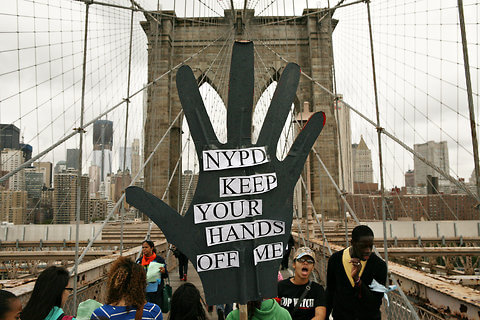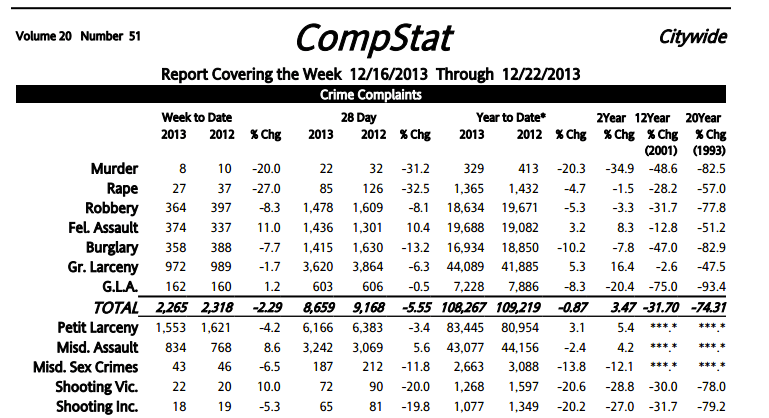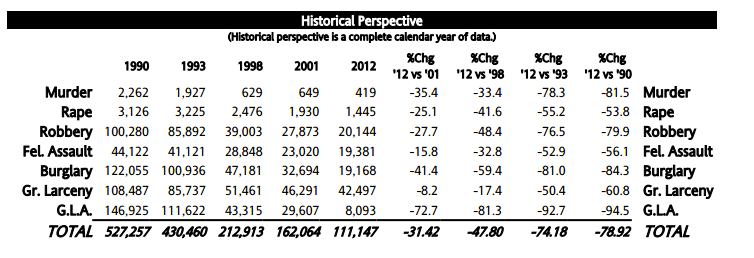What Does New York City’s Record Low Murder Rate Say About the Efficacy of Stop-and-Frisk?

Ozier Muhammad c/o nytimes.com
On Saturday, I went out for drinks with my mother and a friend of mine and—as I usually, unfortunately, ridiculously do when I’m around my mother—reverted to my adolescent self and took the opportunity to complain about how my mother wouldn’t let me walk to school by myself when I was in 4th grade. I explained to my friend that everyone else got to, which, while clearly being not a good reason at all, still was something that I said, as an adult. My mother defended her reasonable, decades-old decision by reminding me that it was a different time back then. It was 1990. Quiet, sparsely trafficked Riverside Drive was not the safest place for a small-for-her-age 9-year-old to be walking all alone. Children had to walk to school with extra money in case they were mugged. And my mother had to walk my younger brother and it was on her way to work anyway and maybe I shouldn’t be such a jerk. Well. She didn’t say any of that because she’s too nice, but probably she should have said it because I’m forever in need of tough love.
But so, my point. My point is that New York is different than it was in the 90s, and one of the ways that it’s different is that young children can walk to school on their own now. (And they do! I see them on the streets like so many scampering little rodents every day.) We all know that crime has dropped. And dropped. And dropped! But the newly released crime statistics for 2013 demonstrate not only that crime has plummeted from the already record lows of the last few years, but that it has done so even with an accompanying major reduction in use of stop-and-frisk by the New York Police Department. The much-maligned tactic was dramatically scaled back this year (due to, among other things, massive protests and lawsuits against the city), with the NYPD wound up employing stop-and-frisk 60% less frequently than in the past. It’s hard not to claim the decrease in stop-and-frisk and the still plummeting murder rate as a victory for opponents of the controversial policing tactic, especially considering how both outgoing Mayor Bloomberg and Police Commissioner Ray Kelly promised a return to the crime-ridden days of the 80s and 90s should stop-and-frisk be abandoned.
Incoming mayor Bill de Blasio made stop-and-frisk a big part of his campaign, actively speaking out against it, and releasing a video of his son, Dante, who spoke about what it was like to be a young African-American man in this city. And yet, even though he derided the use of stop-and-frisk, de Blasio selected former NYPD commissioner William Bratton to take the reins again, despite Bratton’s prior advocacy of the tactic. Perhaps this was just de Blasio’s way of answering his critics who feel that he will be soft on crime, or perhaps Bratton will do as he recently pledged and “end unconstitutional stop-and-frisk,” instead reforming the method so that it isn’t just systematic, race-based harassment. We will have to wait and see how de Blasio and Bratton fulfill the promises that de Blasio made during his campaign, but, for now, it is a positive and reassuring sign that a reduction in stop-and-frisk did not mean an increase in violent crime. Let’s hope that this sends a strong signal to the demagogues who advocate fascist policing tactics in an effort to scare New Yorkers about the future.
Follow Kristin Iversen on twitter @kmiversen




You might also like 



















